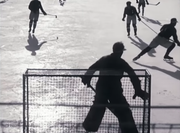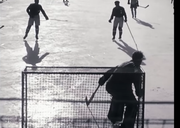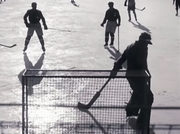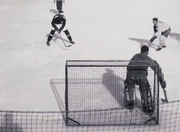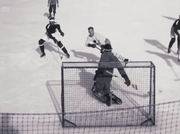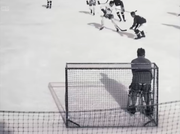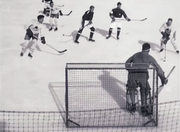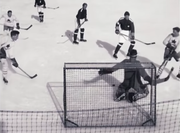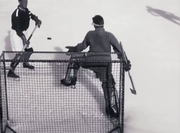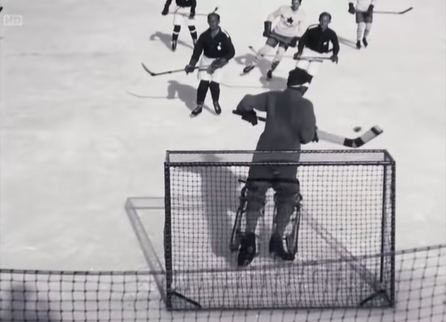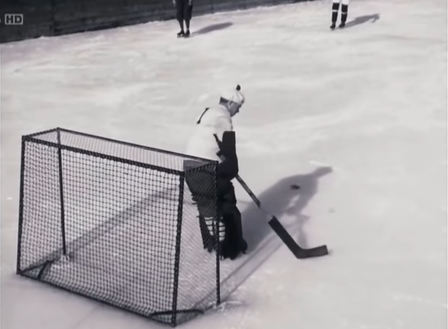tarheelhockey
Offside Review Specialist
A bit more context for the tactics and strategies on display in these videos.
Some users may have access to "Ice Hockey: A Manual for Players and Coach", published in 1926. It can be found at this link, though it seems there are some restrictions on access. For those who can't access it, see the notes below:
- Apparently the author was a Hobey Baker fan, dedicating the book to him and singing his praises in a loosely-written chapter called "Reminiscences".
- Defines hockey as requiring 6 players -- the topic of rovers is not mentioned. This is not entirely surprising as rovers had been dropped from pro hockey in 1923, but the absence of even a retrospective mention of them is noteworthy.
- Pond rink dimensions described as 220' x 90' or 216' x 88', with 40" high boards. Nets described with standard dimensions except for being "a foot or so deep" which is a strikingly shallow construction -- this would have made it a virtual springboard for pucks to bounce off, which helps explain why Art Ross developed the B-shaped net within a few years after this. Goals to be placed 8' from the end boards. Boards make a rectangle, so triangular boxes in the corners ensure the puck continues on its way.
- Intercollegiate Ice Hockey Association of America's 1926 rulebook is provided. Too much to mention here, but I'm happy to look up a rule if anyone has a question.
- Aerobic conditioning, square meals, and 9+ hours of sleep noted as the foundation of good training.
- Good candidates for "backs" (defensemen) would be players who have all the skills of a forward, plus a larger-than-ordinary physical frame through either stockiness or lankiness.
- Centres should be selected for intelligence, stickwork, and defensive ability. Handedness is irrelevant as they are playing in the middle of the ice.
- Goalies should stand slightly off-center to the puck in order to protect their weak side, which would be the right side for a goalie who holds his stick with his right hand. Bear in mind the goalie is holding the stick with both hands, so the logic is that he would find it much easier to cover the left side of the net. This applies also to kick saves, where the stick blade should be used in tandem with the skate. Note the positioning about 6 inches off-center:

- Emphasis for the goalie to try to square up and take the puck straight-on with the pads or torso if possible. When catching, don't close the hand but deflect or toss the puck aside. Clearing rebounds with the stick is a critical skill.
- Start of game, which implies general player positioning with the puck at center ice:

- Backs (defensemen) should be positioned about a quarter of the way up the rink, 6 feet apart from each other. They should move up and down, but should not cross the center line. Rushes should be intercepted about 15' from the net. Emphasis is on maintaining gaps with correct use of speed. Protect the middle of the ice at all costs, forcing the play wide. In tandem, one D plays the body while the other picks up the puck. The one with the puck has an option to start a rush with the forward line, or continue skating back behind his net to set up an orderly advance.


- When a D leads the rush, the forward whose lane he has occupied should drop back as a D. The manual mentions a new strategy where the entire forward line drops back and the two D lead a rush together.
- The basic principles of a forward rush are along the lines of using diagonal or drop passes to isolate a defensive player against 2 attackers and open up an opportunity for a shot. Deception and speed are the determining factors of success. Individual puck-carrying moves include banking the puck off the boards or lobbing it over an opponent to chase it down. Once inside the zone, the focus is getting in on net quickly with a pass or deke before back-pressure arrives. The C should drive the middle of the ice and force the D to protect that lane, allowing the C to make a quick pass out to the wing for a chance on net. Head and shoulder fakes are key to selling the D on covering the wrong lane.





In the event that an opportunity doesn't open up, circle behind the net for a pass-out. Note the C filling the LW's open lane for a back door chance:

There seems to be a really important assumption here -- primary offensive chances will come quickly off a rush, not by moving the puck systematically around the offensive zone.
- If the play is driven to the corner, one option is to pass out to the D for a long shot. But, this would put the forward line off side, so they can't pursue the rebound and must retreat back to where the shot was taken before they can proceed. The D are mentioned as being capable of taking valid shots, but only in the context of a failure by the forward line which are now hemmed into a corner and at risk of turning the puck over if they don't pass back to the D.
- "Triangle" systems on both offense and defense are described, and then dismissed as weak options. Both involve the center playing in a triangular formation with his teammates. In both cases it is noted that opposing teams can easily counter such a formation.
- This manual recommends using the C as the "safety" player who curls back after passing to ensure that his own D doesn't get outnumbered on a counterattack. It acknowledges that the back-side winger can also fill this purpose while the C rushes ahead, but recommends against using that tactic for various positional reasons.
- When the forwards backcheck, the wingers should crowd the center lane in order to force the play wide, then jump out to intercept the puck carrier as he moves up the boards. The recommended tactic is a stick lift combined with taking the body, allowing the loose puck to be picked up by the D.


- Wraparounds, which are not called by that term, are described as a useful "trick". It also describes with near-perfect precision the exact backhand power move that Malkin famously used to beat Cam Ward for a hat trick goal in the 2009 playoffs.
- Icing the puck is recommended as a smart late-game defensive play, not yet being illegal.
- Nighbor-style hook checks are described as a "trick" but the tone is that they should be fairly uncommon for players of modest ability.
- Notably, the manual recommends doing the classic beaver-tail clap if you're open for a pass. Apparently beer leaguers everywhere are building on at least a hundred years of history with that one.
Other images:


There are also some staged photos of players in various postures (shooting the puck, fighting for a faceoff, etc) but I don't think those tell us very much that we didn't already know.
Some users may have access to "Ice Hockey: A Manual for Players and Coach", published in 1926. It can be found at this link, though it seems there are some restrictions on access. For those who can't access it, see the notes below:
- Apparently the author was a Hobey Baker fan, dedicating the book to him and singing his praises in a loosely-written chapter called "Reminiscences".
- Defines hockey as requiring 6 players -- the topic of rovers is not mentioned. This is not entirely surprising as rovers had been dropped from pro hockey in 1923, but the absence of even a retrospective mention of them is noteworthy.
- Pond rink dimensions described as 220' x 90' or 216' x 88', with 40" high boards. Nets described with standard dimensions except for being "a foot or so deep" which is a strikingly shallow construction -- this would have made it a virtual springboard for pucks to bounce off, which helps explain why Art Ross developed the B-shaped net within a few years after this. Goals to be placed 8' from the end boards. Boards make a rectangle, so triangular boxes in the corners ensure the puck continues on its way.
- Intercollegiate Ice Hockey Association of America's 1926 rulebook is provided. Too much to mention here, but I'm happy to look up a rule if anyone has a question.
- Aerobic conditioning, square meals, and 9+ hours of sleep noted as the foundation of good training.
- Good candidates for "backs" (defensemen) would be players who have all the skills of a forward, plus a larger-than-ordinary physical frame through either stockiness or lankiness.
- Centres should be selected for intelligence, stickwork, and defensive ability. Handedness is irrelevant as they are playing in the middle of the ice.
- Goalies should stand slightly off-center to the puck in order to protect their weak side, which would be the right side for a goalie who holds his stick with his right hand. Bear in mind the goalie is holding the stick with both hands, so the logic is that he would find it much easier to cover the left side of the net. This applies also to kick saves, where the stick blade should be used in tandem with the skate. Note the positioning about 6 inches off-center:

- Emphasis for the goalie to try to square up and take the puck straight-on with the pads or torso if possible. When catching, don't close the hand but deflect or toss the puck aside. Clearing rebounds with the stick is a critical skill.
- Start of game, which implies general player positioning with the puck at center ice:

- Backs (defensemen) should be positioned about a quarter of the way up the rink, 6 feet apart from each other. They should move up and down, but should not cross the center line. Rushes should be intercepted about 15' from the net. Emphasis is on maintaining gaps with correct use of speed. Protect the middle of the ice at all costs, forcing the play wide. In tandem, one D plays the body while the other picks up the puck. The one with the puck has an option to start a rush with the forward line, or continue skating back behind his net to set up an orderly advance.


- When a D leads the rush, the forward whose lane he has occupied should drop back as a D. The manual mentions a new strategy where the entire forward line drops back and the two D lead a rush together.
- The basic principles of a forward rush are along the lines of using diagonal or drop passes to isolate a defensive player against 2 attackers and open up an opportunity for a shot. Deception and speed are the determining factors of success. Individual puck-carrying moves include banking the puck off the boards or lobbing it over an opponent to chase it down. Once inside the zone, the focus is getting in on net quickly with a pass or deke before back-pressure arrives. The C should drive the middle of the ice and force the D to protect that lane, allowing the C to make a quick pass out to the wing for a chance on net. Head and shoulder fakes are key to selling the D on covering the wrong lane.





In the event that an opportunity doesn't open up, circle behind the net for a pass-out. Note the C filling the LW's open lane for a back door chance:

There seems to be a really important assumption here -- primary offensive chances will come quickly off a rush, not by moving the puck systematically around the offensive zone.
- If the play is driven to the corner, one option is to pass out to the D for a long shot. But, this would put the forward line off side, so they can't pursue the rebound and must retreat back to where the shot was taken before they can proceed. The D are mentioned as being capable of taking valid shots, but only in the context of a failure by the forward line which are now hemmed into a corner and at risk of turning the puck over if they don't pass back to the D.
- "Triangle" systems on both offense and defense are described, and then dismissed as weak options. Both involve the center playing in a triangular formation with his teammates. In both cases it is noted that opposing teams can easily counter such a formation.
- This manual recommends using the C as the "safety" player who curls back after passing to ensure that his own D doesn't get outnumbered on a counterattack. It acknowledges that the back-side winger can also fill this purpose while the C rushes ahead, but recommends against using that tactic for various positional reasons.
- When the forwards backcheck, the wingers should crowd the center lane in order to force the play wide, then jump out to intercept the puck carrier as he moves up the boards. The recommended tactic is a stick lift combined with taking the body, allowing the loose puck to be picked up by the D.


- Wraparounds, which are not called by that term, are described as a useful "trick". It also describes with near-perfect precision the exact backhand power move that Malkin famously used to beat Cam Ward for a hat trick goal in the 2009 playoffs.
- Icing the puck is recommended as a smart late-game defensive play, not yet being illegal.
- Nighbor-style hook checks are described as a "trick" but the tone is that they should be fairly uncommon for players of modest ability.
- Notably, the manual recommends doing the classic beaver-tail clap if you're open for a pass. Apparently beer leaguers everywhere are building on at least a hundred years of history with that one.
Other images:


There are also some staged photos of players in various postures (shooting the puck, fighting for a faceoff, etc) but I don't think those tell us very much that we didn't already know.










